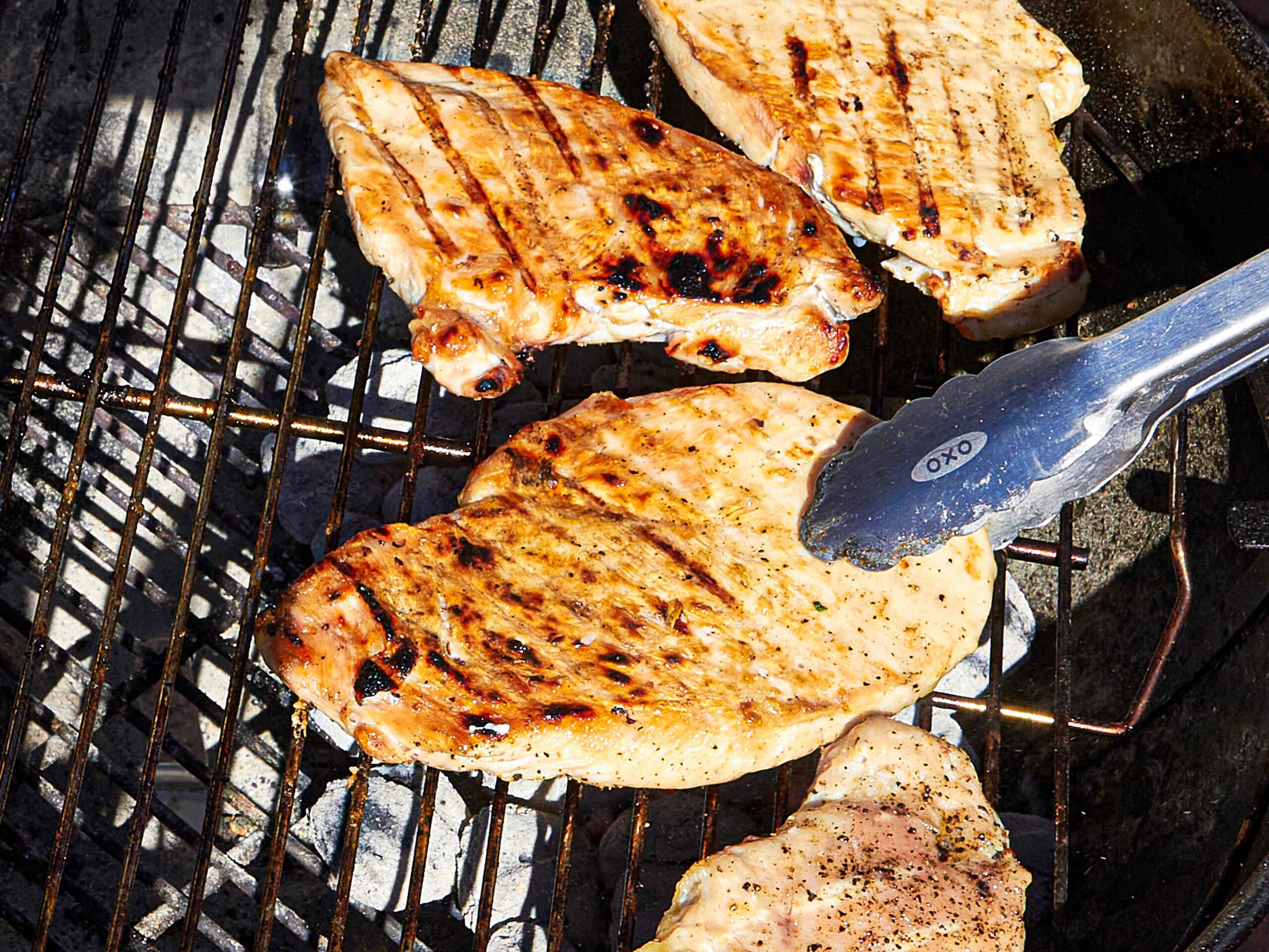:max_bytes(150000):strip_icc():format(jpeg)/20250724-GrillingCleanTip-LorenaMasso-01-79e03c225ced4dd1bc185be78c017ed5.jpg)
Avoid stuck-on food and grill disasters with this three-step method: preheat the grates, clean them thoroughly, and oil them while hot. It only takes five minutes, but it makes all the difference between grilling glory and a mangled mess.
I don’t take much in life seriously. I’m known to crack a startlingly inappropriate joke during a medical emergency or roast myself in front of my kids just to keep the mood light. But there’s one thing I will never joke about: mangled food stuck to the grill.
Getting those beautiful, photo-op-worthy grill marks that turn a simple chicken breast or basic slab of zucchini into a showstopper is serious business. Ensuring that the ribeye develops a crisp crust and releases cleanly is nothing to laugh about. And I’ve ruined enough meals with stuck-on messes to know exactly how frustrating it is.
You go to flip those beautiful chicken thighs you spent hours marinating, already picturing the perfect grill marks. But when you go to flip them, disaster strikes. The chicken is completely stuck. You try to nudge it loose, but it just tears and makes it worse. Now, half of it is stuck to the grate, and the other half looks like it got mauled by Wolverine. To be honest, if you’ve reached this point, all hope is lost, and it’s OK if you shed a tear or two.
But after many years of perfecting my grilling game in both professional and personal contexts, I can confidently say this heartache is completely avoidable. It only takes about five minutes and three simple steps (preheating, cleaning, and oiling the grill) to achieve a nonstick grilling surface.
The 3-Step Method to a Nonstick Grill
These steps might seem like no-brainers at first glance, but many people routinely skip one or more. All three matter, and together they make the difference between a clean flip and a frustrating mess.
Step 1: Preheat Until Hot
Many home cooks assume their grill is sufficiently preheated just a few minutes after lighting it. However, unless you give it enough time to heat the grates thoroughly, you’re not setting yourself up for success. Food is far more likely to stick to cold or lukewarm grates.
When the grates aren’t hot enough, moist, raw proteins are more likely to bond with the metal before the surface of the meat itself can sear and dehydrate. It’s that initial, high-heat sear that ensures food releases cleanly later. A properly preheated grill almost instantly evaporates surface moisture and denatures proteins that are in contact with it, forming a crust that lifts easily when it’s time to flip.
The steps for proper preheating are as follows:
- For a Charcoal Grill: Light the coals in a chimney starter and wait until they’re fully ignited, glowing red, and lightly coated with gray ash. Pour the hot coals into the grill, adjust the vents for airflow, cover it with the lid, and let it preheat for about 5 minutes or until it reaches your desired grilling temperature.
- For a Gas Grill: Turn all the burners to high with the lid open to ignite the grill. Then close the lid and let it preheat for about 15 minutes, or until the internal temperature hits your target cooking range.
When the grill is properly preheated, not only does food stick less, but it will also guarantee those photogenic grill marks we all want with our grilled food.
Step 2: Scrape the Grates Clean
Once your grill is ripping hot, it’s time to scrape the grates. Don’t wait until after cooking to clean the grill—this step should be done right after preheating, before the food goes on. Any crusty leftovers from your last cookout become prime sticking material, so it’s best to remove them.
A good-quality grill brush is your best friend here. Look for one with a long handle and sturdy bristles or scouring pads. Some folks worry about loose metal bristles ending up on the grates (and then, yikes, in the food), but that’s usually only an issue with worn-out or cheaply made brushes. If you invest in a solid one and replace it once the bristles start to break down, you’re in the clear. (It is also a good habit to take a close look after brushing just to verify that the brush itself left nothing unwanted behind.)
If you’re brush-averse—or just want to impress your friends on Instagram—I’ll admit that the onion hack works too. For this, you slice a large onion in half, stab it on the end of a long fork, and scrub the flat cut side of the onion across the hot grates. The moisture and mild acidity help steam and lift off burnt-on bits. Yes, it’s charming and it smells great, but if you don’t want to sacrifice your onions to the cleaning gods, a brush (or even a ball of foil gripped with tongs) will do the job just as well, without wasting food.
The goal is simple: start with clean, bare metal that’s ready for the next step.
Step 3: Oil the Grates (When They’re Hot)
If my anecdotal experience is correct, this is the step most people skip, especially if they’ve already coated their food in oil or a marinade. And sure, it might seem redundant to oil the grates when your chicken thighs are already slicked up like they’re headed to a tanning bed. But skipping this step is still a mistake.
Oiling the hot grates creates a thin, even film that bonds to the metal and acts like a semi-nonstick layer—much like seasoning a cast iron pan. That layer helps ensure your food releases cleanly, even if there are gaps in your marinade or dry spots on the surface. It’s a low-effort insurance policy against tearing, sticking, or losing that precious crust you worked so hard to build.
To do it properly, once your grates are clean and blazing hot, take a folded paper towel, dip it in a neutral, high smoke-point oil (such as canola, vegetable, or grapeseed), and use tongs to rub it across the grates in a thin, even layer. Don’t overdo it; too much oil can cause flare-ups. A light swipe is all you need.
It only takes a minute, but this step makes a big difference, especially when cooking lean proteins like chicken breast, fish, or shrimp, which tend to stick the most.
The Takeaway
Five minutes of prep—preheating, cleaning, and oiling—can save your dinner and your dignity. It’s easy to assume that sticking is just part of grilling, but it doesn’t have to be that way. Just a few minutes of care upfront means you can flip with confidence, serve with pride, and maybe even earn a few bragging rights on how great your food looks.

